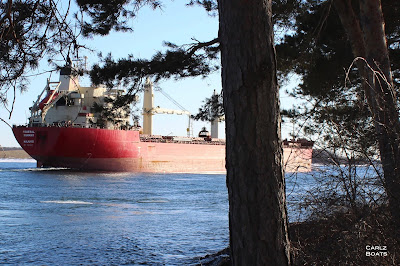It’s that time of year again. It just seems like yesterday that I was standing at Loyalist Park about midway between Morrisburg and Iroquois on Lakeshore Drive waiting for the first upbound of the new shipping season, the 656’ Fednav bulk carrier FEDERAL KUMANO to motor by. While the weather conditions were almost identical with a scattering of snow on the ground and temps hovering above freezing, it was actually 9 months plus 2 days from my first to Saturday’s last run to the St. Lawrence River.
 |
| FEDERAL ALSTER unloading at Ogdensburg, N.Y. - September 30. 2019 |
True, I would have liked to get the very last downbound saltie of the season but the FEARLESS was still somewhere out on Lake Erie, it was virtually empty due to a freezing problem in her lines that was discovered in Thunder Bay. There were even concerns that she maybe wintering there. She was to be passing through Iroquois Lock later Sunday afternoon which was when a major ice and winter storm was to blow through our neck of the woods, making it pretty risky for my drive from Ottawa to the River and back. As it turned out though the FEARLESS motored from the Lakehead high in ballast on schedule and the winter storm was a day late. What are you going to do 😁.
However as an added bonus, I saw that the 740' Algoma Central self unloader ALGOMA MARINER was also making her last upbound river run so it was off to Brockville to catch her first. |
| ALGOPORT unknowingly leaving Great Lakes for last time - taken by Ron Beaupre - June 28, 2009 |
 |
| ALGOMA MARINER about unload more road salt at the Port of Johnstown - June 18, 2018. |
 |
| Wheelhouse similar to next generation Equinox-class newbuilds. |
When the new vessel arrived at Port Cartier on August 2, 2011 to pick up a load iron ore pellets for a Hamilton steel mill, her port of registry was Toronto, where previous-owner's head office was located but soon after it was changed to Port Colborne and then dedicated at a special ceremony at the Lake Erie port on August 25, 2011 in recognition of the communities long standing relationship with Algoma Central and for company’s subsidiary Fraser Ship Repairs, which has been based in Port Colborne for many years. Kudos to Algoma Central for that and the ship-like designed skateboard park at Lock 8 which is named ALGOPORT.
 |
| Downbound ALGOMA MARINER plays peekaboo between the shoreline trees and islets east of Cornwall - June 15, 2015 |
Meanwhile, coming up in Part 2 of my "Last River Run" we'll be at Iroquois Lock to meet up with the FEDERAL ALSTER during her escape from the Great White ⛄ North and in the distance, another "Red Boat". Canadian Coast Guard ship GRIFFON. I wonder what she's up to? Well you'll find out NEXT YEAR!!! Until then have a Happy New Year 🎉, thanks for reading my blog and saying so many nice things about my pics. Take care and I wish you All the Best in 2020. 👋.












































